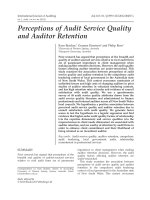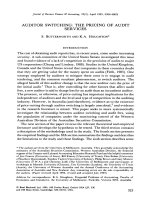klein - 2002 - economic determinants of audit committee independence
Bạn đang xem bản rút gọn của tài liệu. Xem và tải ngay bản đầy đủ của tài liệu tại đây (190.09 KB, 18 trang )
435
THE ACCOUNTING REVIEW
Vol. 77, No. 2
April 2002
pp. 435–452
Economic Determinants of
Audit Committee Independence
April Klein
New York University
ABSTRACT: This paper provides empirical evidence that audit committee in-
dependence is associated with economic factors. I find that audit committee
independence increases with board size and board independence and de-
creases with the firm’s growth opportunities and for firms that report consec-
utive losses. In contrast, no relation is found between audit committee inde-
pendence and creditors’ demand for accounting information. Although the
analyses are based on data from 1991 to 1993, these results have implications
for NYSE and NASDAQ listing requirements for audit committees adopted in
December 1999. Specifically, the new requirements give firms the option of
including non-outside directors on their audit committees if it is in the best
interests of the firm to do so.
Keywords: audit committee; outside directors; corporate governance; board
of directors.
Data Availability: Data used for this study are derived from a proprietary
database.
Just as ‘‘one size doesn’t fit all’’ when it comes to board governance, ‘‘one size can’t
fit all’’ audit committees. Within broad parameters, each audit committee should evolve
and develop its own guidelines suited to itself and its corporation.
—New York Stock Exchange and National Association of Securities Dealers (1999)
I. INTRODUCTION
I
n December 1999, in response to the SEC’s call for improving the effectiveness of
corporate audit committees in overseeing the financial-reporting process (Levitt 1998),
the NYSE and NASDAQ modified their listing requirements for large U.S. companies.
Under the new standards, firms must maintain audit committees with at least three directors,
‘‘all of whom have no relationship to the company that may interfere with the exercise of
their independence from management and the company’’ (NYSE Listed Company Manual
Financial support is provided by a summer grant from the Stern School of Business. I thank Ashiq Ali, Eli
Bartov, Stephen Bryan, Eric Koh, Baruch Lev, James Ohlson, Jeffrey Simonoff, the editor (Michael Bamber), two
anonymous referees, and the NYU Accounting and Statistics Departments for their constructive comments.
Submitted April 2000
Accepted November 2001
436 The Accounting Review, April 2002
§303.01[B][2][a]). Although this statement implies that firms must maintain audit commit-
tees with outside members only, listing requirements provide for the appointment of certain
affiliated directors if the board determines it is in the best interests of the corporation for
these individuals to serve on its audit committee (see NYSE Rule §303.01[B][3][b] and
NASDAQ Rule 4310[c][26][B][ii]). Thus, firms have some flexibility in determining audit
committee composition.
Because enforcement standards are constantly evolving, one question of interest is to
what degree the SEC and the exchanges should allow firms to exercise this option. I provide
insights into this question by examining economic determinants behind differences in audit
committee independence for a sample of more than 400 large U.S. firms that were publicly
traded during most of 1991–1993. During this time, exchange rules allowed more flexibility
with respect to audit committee independence and many firms opted for audit committees
with less than 100 percent outside directors (Vicknair et al. 1993; Verschoor 1993; Klein
1998, 2001; Parker 2000).
I develop predictions and test determinants of audit committee independence. I expect
and find that the percentage of outside directors on the audit committee is limited by board
size and overall board independence. Firms incur costs in expanding the board to include
more outside directors (e.g., Yermack 1996) and in enlisting outside directors instead of
inside directors who have firm-specific knowledge (e.g., Fama and Jensen 1983; Klein
1998). Thus, audit committee independence is costly to the firm.
I expect the demands for audit committee independence to emanate from management,
shareholders, and creditors. Consistent with my expectation that managers’ demand for
directors with inside expertise increases in proportion to the complexities and uncertainties
associated with growth opportunities (Williamson 1975), I find that audit committee inde-
pendence decreases with the firm’s growth opportunities. Consistent with the hypothesis
that shareholders’ demand for accurate, unbiased financial accounting data depends on the
published financial accounting data’s potential informativeness for equity valuation, I find
that firms that have experienced two or more consecutive losses (which typically are less
value-relevant than positive profits) have less independent audit committees. However, I
find no evidence that audit committee independence is associated with the degree of debt
in the firm’s capital structure. This result is inconsistent with the expectation that creditors’
demand for unbiased accounting data for use in debt covenants increases with debt.
1
One implication of these findings is that firms tailor audit committee composition to
suit their specific economic environments. This suggests that the SEC and the stock ex-
changes may wish to continue to allow firms some flexibility to include non-outside direc-
tors on their audit committees.
II. THE AUDIT COMMITTEE
The Audit Committee’s Role as Monitor of the Firm’s Financial-Reporting Process
By state law, boards of directors may conduct their work through the full board or
delegate their authority to standing committees responsible to the board—for example,
Delaware General Corporate Law §141(c) allows boards to set up committees. One such
committee is the audit committee.
The audit committee provides, on behalf of the board of directors, oversight respon-
sibility for the firm’s financial-reporting process. According to the Blue Ribbon Committee
1
Creditors also use accounting numbers to assess firm value in liquidation (as in the abandonment option). See,
for example, Barth et al. (1998).
Klein—Economic Determinants of Audit Committee Independence 437
Report, the audit committee is the ‘‘the ultimate monitor’’ of the financial accounting re-
porting system (NYSE and NASD 1999, 7). The audit committee selects the outside auditor
and meets separately with senior financial management and with the external auditor. The
committee also questions management, internal auditors, and external auditors to determine
whether they are acting in the firm’s best interests.
2
Consistent with the Blue Ribbon Committee Report and with prior studies (e.g., Carcello
and Neal 2000), I assume that audit committee members who are independent of manage-
ment are better monitors of the firm’s financial accounting process.
3
Benefits of effective
monitoring include transparent financial statements, active trading markets, and the ability
to use unbiased financial accounting numbers as inputs into contracts among shareholders,
senior claimants, and management.
NYSE and NASDAQ Audit Committee Requirements
Before December 1999, stock exchanges’ and NASDAQ’s rules for audit committee
composition were vague at best. They required or encouraged large, U.S listed companies
to maintain audit committees with all or a majority of their members independent of man-
agement. However, the listing requirements did not define ‘‘independence.’’
4
In December 1999, the NYSE and NASDAQ modified their audit committee require-
ments, based on their Report and Recommendations of the Blue Ribbon Committee on
Improving the Effectiveness of Corporate Audit Committees, which they had issued in the
previous February. Simultaneously, the SEC adopted new rules to improve disclosures re-
lated to audit committees (see SEC Release No. 34-42266, Adopting Rules Regarding Dis-
closure by Audit Committees, Including Discussions with Auditors Regarding Financial
Statements). All large, U.S listed companies must now maintain audit committees with at
least three independent directors.
5
Both exchanges disallow directors from serving on the
audit committee if they are current employees, have been employees within the last three
years, have cross-compensation committee links, or are immediate family members of an
executive officer. In addition, the NASDAQ bars from the audit committee directors who
accept more than $60,000 in non-director compensation from the firm, or whose employers
received at least $200,000 from the firm in any of the three past years.
However, both the NYSE and NASDAQ allow the firm to appoint to the audit commit-
tee directors who have business relationships with the firm if the board determines that the
individual’s membership on the committee is in the corporation’s best interests. NASDAQ
Rule 4310(c)(26)(B)(ii) allows the board under ‘‘limited circumstances’’ to appoint one
former employee or family member to the audit committee if the board determines this is
in the best interest of the corporation and its shareholders. NYSE §303.01(B)(3)(b) gives
the board greater discretion. If the board determines that the business relationship does not
2
For example, see Audit Committee Effectiveness—What Works Best, a guide for audit committees written by
PricewaterhouseCoopers (2000), under the aegis of the Institute of Internal Auditors Research Foundation.
3
Fama and Jensen (1983) and Fama (1980) also argue that outside directors have incentives to effectively monitor
top management.
4
Advocacy of independent audit committees has a long tradition. In 1940, the SEC first recommended that firms
establish audit committees with only nonofficer board members (Accounting Series Release No. 19). In October
1987, the Treadway Commission advocated that audit committees include only independent directors (National
Commission on Fraudulent Financial Reporting 1987).
5
See NYSE Listed Company Manual, New York Stock Exchange, §303.01(B)(2)(a), and The NASDAQ Stock
Market Listing Requirements, National Association of Securities Dealers, §4310(c)(26)(B). See also SEC Release
Nos. 34-42231, 34-42232, and 34-42233, Adopting Changes to Listing Requirements for the NASD, AMEX, and
NYSE Regarding Audit Committees.
438 The Accounting Review, April 2002
compromise the individual’s independence, then that director may serve on the board’s
audit committee. Thus, despite recent changes in exchange requirements, audit committee
independence is still an open issue.
III. DETERMINANTS OF AUDIT COMMITTEE INDEPENDENCE
Board Size and Board Independence
I develop hypotheses relating audit committee independence to the supply of available
outside directors. Because the audit committee is a subset of the full board, its composition
depends on the board’s overall structure.
Lipton and Lorsch (1992), Jensen (1993), and Yermack (1996) argue that the board’s
decision-making quality decreases with board size because the more people in the group,
the lower the group’s coordination and processing skills (see Steiner 1972; Hackman 1990).
Yermack (1996) finds evidence consistent with this argument. Specifically, Tobin’s Qs,
several accounting profitability ratios, and CEO turnover rates are negatively related to
board size.
If the firm limits board size, then the number of directors available to serve on the
audit committee also will be limited. The typical board has between three and six board
committees to staff, with each committee having at least two members (Klein 1998). Two
committees, the executive compensation committee and the nominating committee, require
independent directors to ensure monitoring. Thus, a smaller board may have to choose one
or more nonindependent directors to serve on the audit committee to meet overall committee
staffing needs.
Stated in the alternative form:
H1: Audit committee independence is positively related to the number of directors
sitting on the entire board.
The larger the pool of outside directors on the board, the easier it is for the board to
have an independent audit committee. However, boards require both outside and non-outside
directors to fulfill their duties. Outside directors serve as monitors and help alleviate agency
conflicts between shareholders and upper management. Inside and affiliated directors have
the specialized expertise about the firm’s activities to evaluate and ratify its future strategic
plans (Williamson 1975; Fama and Jensen 1983). Consistent with this argument, Klein
(1998) finds that the percentage of inside directors on board investment or finance com-
mittees is positively associated with firm value. Thus, board independence reflects the trade-
off between director independence and director expertise, which, in turn, reflects the bal-
ancing of the firm’s monitoring needs and its requirements for specialized information.
If board independence varies across firms, then, in the alternative form:
H2: Audit committee independence is positively related to board independence.
The Demands for Audit Committee Independence
Growth Opportunities
Williamson (1975) and Fama and Jensen (1983) argue that a firm structures its board
in response to its needs to obtain unbiased, expert information. Both papers assert that a
board’s demand for knowledgeable directors increases with the firms’ complexity and un-
certainties. Inside directors have direct knowledge about their firm’s operations and invest-
ment horizons. Affiliated directors or their companies have ties with the firm and often
provide expertise to the firm about suppliers, customers, financial opportunities, or legal
Klein—Economic Determinants of Audit Committee Independence 439
issues. Because of the complexities and uncertainties associated with growth opportunities,
I expect high-growth opportunity firms’ managers and shareholders to demand less inde-
pendent boards, resulting in less independent audit committees.
In the alternative form:
H3: Audit committee independence is negatively related to the firm’s expected growth
in earnings or cash flows.
Consecutive Losses
Hayn (1995), Lipe et al. (1998), Amir et al. (1999), and Collins et al. (1999) show that
the cross-sectional returns (or price) earnings relation is much weaker for firms reporting
losses than for firms reporting profits. In addition, Hayn (1995) reports negative coefficients
on the regression of returns on earnings, with R
2
values near 0.0 percent, for her sample
of firms posting losses over two or more consecutive years. These studies suggest that
financial statements on the whole are less value-relevant for firms suffering repeated losses
than for profitable firms. Thus, I expect shareholders of firms with past consecutive
losses to demand less scrutiny of the financial-reporting system and, consequently, to have
a lower demand for audit committee independence.
In the alternative form:
H4: Audit committee independence is lower for firms reporting a series of consecutive,
past losses.
Creditors
Creditors write debt contracts that contain accounting-based covenants to monitor man-
agement and shareholders (Jensen and Meckling 1976; Smith and Warner 1979; Leftwich
1983; Watts and Zimmerman 1990). However, managers sometimes manipulate earnings to
delay or avoid debt covenant violations. For example, DeFond and Jiambalvo (1994) con-
clude that managers overstate earnings in the year before debt covenant violations. Thus,
creditors’ demand for audit committee independence should increase with the firm’s debt-
to-assets ratio due to their increased demands for monitoring the integrity of the firms’
financial accounting reports.
In the alternative form:
H5: Audit committee independence is positively related to the firm’s debt-to-assets
ratio.
CEO on Compensation Committee
Although exchange and NASDAQ regulations restrict the CEO from serving on the
board’s audit committee, no regulations prohibit the CEO from sitting on the board’s ex-
ecutive compensation committee. I make no prediction, ex ante, about the sign of the
relation between the CEO serving on the compensation committee and audit committee
independence. On the one hand, a board that allows its CEO to sit on its executive com-
pensation committee may be CEO-friendly, thus providing less monitoring of the firm’s
financial accounting reporting process. For example, Klein (2001) finds that earnings man-
agement is higher in firms where the CEO serves on the board’s compensation committee.
On the other hand, shareholders may want to curb the CEO’s ability to distort financial
statements by demanding greater audit committee independence. Thus, Hypothesis 6 is
nondirectional:
440 The Accounting Review, April 2002
H6: Audit committee independence is different if the CEO sits on the board’s executive
compensation committee than if the CEO does not.
Substitute Monitoring Mechanisms
Nonmanagement blockholders (or their representatives) sometime serve on the audit
committee, giving them the opportunity to monitor the firm’s financial-reporting process.
Klein (1998, 2001) finds that firms with large, non-inside stockholders on audit committees
are more productive and exhibit less earnings management. If large, nonmanagement block-
holders on the audit committee actively monitor the financial-reporting process, then there
is less need for outside directors on the audit committee.
In the alternative form:
H7: Audit committee independence is lower if a large, non-inside shareholder sits on
the board’s audit committee.
Jensen and Meckling (1976) argue that directors’ shareholdings act as a monitoring
device. If outside director shareholdings substitute for outsiders on the audit committee,
then in the alternative form:
H8: Audit committee independence is negatively related to the percentage of shares
held by outside directors.
Firm Size
I also control for firm size. Larger firms have stronger internal controls systems than
smaller firms (O’Reilly et al. 1998). If the firms’ internal controls act as in-house monitoring
mechanisms, then larger firms require less alternative monitoring of their reporting systems
and therefore need lower levels of audit committee independence. Alternatively, if share-
holders are more apt to sue larger firms for misstated or fraudulent financial statements,
then larger firms may try to inoculate themselves against lawsuits by adopting stronger
monitoring mechanisms, such as greater audit committee independence. Thus, the associ-
ation between firm size and audit committee independence is indeterminate.
IV. RESEARCH DESIGN
Sample Selection
I hand-collected data about boards and board audit committees from SEC-filed proxy
statements. Initially, I include all U.S. firms listed on the S&P 500 as of March 31, 1992
and 1993, with annual shareholder meetings between July 1, 1991, and June 30, 1993.
I exclude 65 bank and financial institution firm-years and 38 insurance company firm-
years. I also delete three firm-years with missing audit committee composition data, and
58 firm-years with missing Compustat or CRSP data. The final sample has 803 firm-year
observations.
Schedule 14A (the proxy statement) requires firms to disclose each director’s name,
current directorships; family relationships between each and any director, nominee or ex-
ecutive officer; significant current or proposed transactions with management; significant
business relationships with the firm, current firm shareholdings, and business experience
during the last five years.
6
Schedule 14A (Item 7[e][1]) requires firms to state whether they
6
Items 404(a) and 404(b) of Regulation S-K of the 1934 Securities and Exchange Act define significant business
transactions. Item 404(a) specifies a threshold of $60,000 for a transaction to be considered significant. Item
404(b) defines ‘‘certain business relationships’’ to include significant payments to the firm in return for services
or property, significant indebtedness by the firm, outside legal counseling, investment banking, consulting fees,
and other joint ventures.
Klein—Economic Determinants of Audit Committee Independence 441
have standing audit, compensation, or nominating board committees. If such committees
exist, then firms must disclose their functions and responsibilities, their members, and the
number of times each committee met during the last fiscal year.
I define outside directors as having no affiliation with the firm other than serving as
directors. Consistent with NYSE and NASD (1999) and with exchange definitions, affiliated
directors include former employees, relatives of the CEO, those with significant transactions
or business relationships with the firm as defined by Items 404(a) and (b) of Regulation S-
K, and those on interlocking boards. Inside directors are current employees.
Regression Model
I measure the associations between audit committee independence and the explanatory
variables by estimating the following regression:
%Audout
ϭ ␣ ϩ  Board Size ϩ  %Outsiders ϩ  Growth Opportunities
12 3
ϩ  Losses ϩ  Debt-to-Assets ϩ  CEO on Compensation Committee
45 6
ϩ  5%Blockholder on Audit Committee ϩ  %Outside Director Holdings
78
ϩ  Firm Size ϩ .
9
%Audout is the logistical transformation of the percentage of outsiders on the audit
committee.
7
Board Size is the natural log of the number of board members (Yermack 1996)
and %Outsiders is the logistical transformation of the percent of outside directors on the
board.
8
I obtain data for these three variables from the shareholders’ meeting proxy state-
ment. Following Smith and Watts (1992), I define Growth Opportunities as the three-year
market value of equity plus the book value of liabilities divided by the three-year book
value of assets, all ending on the fiscal year prior to the shareholders’ meeting.
9
This metric
captures the proportion of firm value represented by growth opportunities relative to assets
in place. Losses equals 1 if the firm reported losses for each of the two years prior to the
firm’s shareholders’ meeting (Compustat item 18 is negative for fiscal years t and tϪ1), and
0 otherwise. Losses captures the diminished value-relevance of financial reporting for firms
experiencing extended periods of losses. Debt-to-Assets is the three-year long-term debt-
to-assets ratio at the end of the fiscal year prior to the shareholders’ meeting (three-year
Compustat item 9 divided by three-year item 6). CEO on Compensation Committee is a
dichotomous variable set to 1 if the CEO sits on the board’s compensation committee, and
0 otherwise. 5%Blockholder on Audit Committee is a dichotomous variable set to 1 if a
nonmanagement director holding at least 5 percent of the firm’s shares sits on the board’s
audit committee, and 0 otherwise.
10
%Outside Director Holdings is the percentage of shares
held by outside directors. The latter two items are in the firm’s proxy statement. Firm Size
is the natural log of the firm’s assets (Compustat item 6) at the end of the fiscal year prior
to the shareholders’ meeting.
7
The logistical transformation is ln(%Audout /(1Ϫ%Audout)ϩ1). I use this transformation because the values of
%Audout are confined to the interval from 0 to 1, whereas the logistically transformed values extend from Ϫϱ
to ϩϱ. Thus, an intrinsically non-normal distribution is transformed into a more normal distribution.
8
I use the latter transformation to be internally consistent with the transformed %Audout variable. Results based
on untransformed values as well as the natural log of %Outsiders are qualitatively the same as those reported
in the text and are not shown separately.
9
The numerator is Compustat items (6 Ϫ 60 ϩ (24 ϫ 25)) summed over fiscal years t, t Ϫ 1, and t Ϫ 2. The
denominator is Compustat item 6 summed over fiscal years t, t Ϫ 1, and t Ϫ 2.
10
I would like to thank Lee-Seok Hwang for these data.
442 The Accounting Review, April 2002
TABLE 1
Composition of Overall Boards of Directors and Audit Committees
a
(1)
Overall
Boards of
Directors
(2)
Audit
Committee
Percentage of Directors Who Are:
Insiders 22.5 1.4
Outsiders 58.4 79.6
Affiliates 19.1 19.0
Percentage of Firms that Have at Least One
Member Who Is:
Inside Director 99.7 4.8
CEO 99.0 1.9
Outside Director 99.0 97.9
Affiliated Director 85.5 54.3
Relative of CEO 11.3 4.3
Former Employee of Firm 51.5 12.3
Percentage of Firms that Have at Least
51% Outside Directors 73.8 86.7
Percentage of Firms that Have 100%
Outside Directors 0 43.4
a
Sample is for 803 U.S. firm-years with audit committees listed on the S&P 500 as of March 31, 1992 and 1993
with annual shareholder meetings between July 1, 1991 and June 30, 1993. Banks, financial institutions, insurance
companies, and firms with missing Compustat or CRSP data are excluded.
V. EMPIRICAL RESULTS
Descriptive Statistics
Table 1 reports data on board and audit committee composition. Consistent with other
board composition studies or surveys, 58.4 percent of the board is outsiders, less than one
quarter (22.5 percent) is insiders, and the rest (19.1 percent) are affiliated directors.
11
In
contrast, the audit committee includes a preponderance of outsiders (79.6 percent) and few
insiders (1.4 percent), but about the same percentage of affiliated directors (19.0 percent).
Because of these affiliated directors, 43.4 percent of firms have audit committees with
outside directors only, and 86.7 percent have a majority of independent directors.
Table 2 presents the mean, median, and 1st and 3rd quartiles of the untransformed
variables used in the regression analysis. The interquartile range for board size is 10–14
members. The interquartile range for %Outsiders is 50.0 percent to 70.6 percent, consistent
with Fama and Jensen’s (1983) argument that boards should include some insiders and
affiliated directors for their expertise.
Growth Opportunities and the Debt-to-Assets ratio have means of 1.40 and 0.27, re-
spectively. 4.6 percent of firms report losses in two or more consecutive years; 9.1 percent
of firms allow the CEO to sit on the executive compensation committee; and 5.7 percent
11
Yermack (1996) reports 54 percent outsiders for his sample of 452 firms listed on the Forbes 500 between 1984
and 1991. Bhagat and Black (1999) report similar percentages of insiders for 957 large U.S. firms in 1991.
Klein—Economic Determinants of Audit Committee Independence 443
TABLE 2
Descriptive Statistics for Untransformed Variables Used in the Analysis of Audit Committee
Independence for a Pooled Sample of 803 Firm-Years 1991–1993
Variable
a
Hypothesis
Number
b
Mean Median 1st Quartile 3rd
d
Quartile
%Audout 79.7% 80.0% 66.7% 99.0%
Board Size 1 12.0 12.0 10.0 14.0
%Outsiders 2 58.4% 60.0% 50.0% 70.6%
Growth Opportunities 3 1.40 1.29 1.11 1.61
%Losses 4 4.6% 0 0 0
Debt-to-Assets 5 0.27 0.27 0.16 0.36
CEO on Compensation
Committee
6 9.1% 0 0 0
5% Blockholder on
Audit Committee
7 5.7% 0 0 0
%Outside Director
Holdings
8 1.58% 0.47% 0.15% 1.82%
Assets ($ million) Control
Variable
8,526 3,190 1,330 8,554
a
Variable definitions:
%Audout ϭ the percent of outside directors on the audit committee;
Board Size ϭ the number of board members;
%Outsiders ϭ the percent of outside directors on the board;
Growth Opportunities ϭ the three-year market value of the total firm (Compustat items (6 Ϫ 60
ϩ (24 ϫ 25)) divided by three-year assets-in-place (Compustat item 6)
ending on the fiscal year prior to the shareholders’ meeting;
%Losses ϭ the percent of firms that reported losses (Compustat item 18) in each of
the two years prior to the shareholders’ meeting;
Debt-to-Assets ϭ the three-year ratio of the book value of debt (Compustat item 9) divided
by the book value of assets (Compustat item 6) ending on the fiscal year
prior to the shareholders’ meeting;
CEO on Compensation Committee
ϭ 1 if the CEO sits on the board’s compensation committee, and 0
otherwise;
5% Blockholder on Audit Committee ϭ 1 if a non-inside director with at least 5 percent of the firm’s shares sits
on the audit committee, and 0 otherwise;
%Outside Director Holdings ϭ the percentage of shares owned by all outside directors; and
Assets ϭ the firm’s book value of assets (Compustat item 6).
b
Hypothesis number refers to the hypotheses in Section III.
include a non-inside director/blockholder on the audit committee. Outside director share-
holdings have an interquartile range of 0.15 percent to 1.82 percent, with a mean of 1.58
percent.
Correlations
Table 3 presents Pearson correlations between the transformed dependent and indepen-
dent variables. Spearman correlations yield similar results. The following correlations sup-
port several hypotheses: %Audout is significantly positively correlated with Board Size
444 The Accounting Review, April 2002
TABLE 3
Pearson Correlations (and p-values) among the Dependent and Explanatory Variables
a
%Audout Board Size %Outsiders
Growth
Opportunities Losses
Debt-to-
Assets
CEO on
Compensation
Committee
5%
Blockholder
on Audit
Committee
%Outside
Director
Holdings
Board Size 0.06
(0.10)
%Outsiders 0.50
(0.01)
0.09
(0.01)
Growth Opportunities
Ϫ0.12
(0.01)
Ϫ0.16
(0.01)
Ϫ0.21
(0.01)
Losses Ϫ0.03
(0.44)
Ϫ0.01
(0.81)
0.02
(0.51)
Ϫ0.11
(0.01)
Debt-to-Assets 0.04
(0.24)
0.19
(0.01)
0.13
(0.01)
Ϫ0.30
(0.01)
0.08
(0.03)
CEO on Compensation
Committee
Ϫ0.17
(0.01)
Ϫ0.15
(0.01)
Ϫ0.25
(0.01)
0.20
(0.01)
Ϫ0.03
(0.42)
Ϫ0.15
(0.01)
5% Blockholder on Audit
Committee
Ϫ0.16
(0.01)
Ϫ0.01
(0.84)
Ϫ0.06
(0.08)
0.07
(0.06)
Ϫ0.03
(0.42)
Ϫ0.09
(0.02)
0.03
(0.34)
%Outside Director
Holdings
0.05
(0.20)
Ϫ0.01
(0.69)
0.09
(0.01)
0.06
(0.08)
0.03
(0.33)
0.02
(0.56)
Ϫ0.02
(0.55)
0.36
(0.01)
Firm Size 0.03
(0.47)
0.54
(0.01)
0.12
(0.01)
Ϫ0.25
(0.01)
Ϫ0.05
(0.14)
0.31
(0.01)
Ϫ0.17
(0.01)
Ϫ0.08
(0.03)
Ϫ0.09
(0.02)
a
Variable definitions:
%Audout ϭ ln(%Audout/ (1 Ϫ %Audout) ϩ 1);
Board Size ϭ the natural log of the number of board members; and
%Outsiders ϭ ln(%Outsiders / (1 – %Outsiders) ϩ 1).
See Table 2 for other variable definitions.
Klein—Economic Determinants of Audit Committee Independence 445
(H1) and %Outsiders (H2). %Audout is significantly negatively correlated with Growth
Opportunities (H3), CEO on Compensation Committee (H6), and 5%Blockholder on Audit
Committee (H7). In contrast, the correlations between audit committee independence and
Losses (H4), Debt-to-Assets (H5), %Outside Director Holdings (H8), and Firm Size are
insignificantly different from zero.
Table 3 also reveals that many explanatory variables are significantly correlated with
each other. The formal hypothesis tests are based on multiple regression analysis.
Multiple Regression Results
The data encompass two consecutive years, with many firms represented in both years.
OLS error terms will suffer from serial correlation, resulting in unbiased coefficients but
understated standard errors. I use Froot’s (1989) procedure to adjust the variance-covariance
matrix for dependence among observations from the same firm.
Table 4 presents the empirical results. %Audout is significantly positively associated
with Board Size (p
Ͻ 0.01) and with %Outsiders (p Ͻ 0.01). These findings are consistent
with H1 and H2, supporting the view that audit committee independence increases with
the supply of available, outside directors.
%Audout is significantly negatively associated with Growth Opportunities (p Ͻ 0.10),
Losses (p Ͻ 0.05), 5%Blockholder on Audit Committee (p Ͻ 0.01), and Firm Size (p
Ͻ 0.05). These findings are consistent with H3, H4, and H7, with Firm Size serving as a
control variable. The negative coefficient on Growth Opportunities supports the view that
managers of growth firms require more board members with specific expertise about their
firms. The negative coefficient on Losses is consistent with shareholders demanding lower
audit committee independence when financial statements are less value relevant. The neg-
ative coefficients on 5%Blockholder on Audit Committee and on Firm Size suggest that
large nonmanagement blockholders and strong internal controls substitute for audit com-
mittee independence. The coefficients on the debt-to-assets ratio (H5), CEO on Compen-
sation Committee (H6), and Outside Director Holdings (H8) are insignificantly different
from zero.
In summary, audit committee independence increases with the supply of available,
independent directors and with the demand for monitoring, and decreases with the availa-
bility of substitute monitoring mechanisms. %Outsiders plays the biggest role in explaining
audit committee independence. A simple regression of %Audout on %Outsiders yields an
R
2
of 0.22, compared with the R
2
of 0.25 from the full multiple regression. Nonetheless,
the other factors collectively play a significant incremental role in explaining the percentage
of outsiders on the audit committee variation in audit committee independence; testing for
the differential in R
2
s yields an F-statistic of 5.07, significant at the 0.01 level.
Additional Tests
Are Growth Opportunities Primarily Capturing Hi-Tech Firms?
The variable, Growth Opportunities, may capture disproportionate numbers of firms in
high-tech industries or with high research and development expenditures.
12
Reingold (1999)
reports that according to Korn/Ferry and Spencer Stuart, high-tech companies such as
Internet firms have fewer outsiders on their boards and smaller board sizes than do other
types of companies.
12
Contrary to this conjecture, Smith and Watts (1992) test and find that R&D expenditures cannot substitute for
this measure of growth opportunities in their analyses. Lev and Zarowin (1999) also find no relation between
R&D expenditures and future growth.
446 The Accounting Review, April 2002
TABLE 4
Explanators of Audit Committee Independence Based on Time-Series Adjusted Regressions
a
for a Pooled Sample of 803 Firm-Years 1991–1993
%Audout ϭ ␣ ϩ

Board Size ϩ

%Outsiders ϩ

Growth Opportunities
12 3
ϩ

Losses ϩ

Debt-to-Assets ϩ

CEO on Compensation Committee
45 6
ϩ

5%Blockholder on Audit Committee ϩ

%Outside Director Holdings
78
b
ϩ

%Firm Size
9
Independent Variables
Predicted
Sign
Hypothesis
Number
Coefficients and
(t-statistics)
Intercept 0.39 (0.56)
Board Size ϩ 1 0.78 (2.62)***
%Outsiders ϩ 2 1.89 (13.50)***
Growth Opportunities Ϫ 3 Ϫ0.06 (Ϫ1.86)*
Losses Ϫ 4 Ϫ0.55 (Ϫ2.32)**
Debt-to-Assets ϩ 5 Ϫ0.26 (Ϫ0.59)
CEO on Compensation Committee ϩ /Ϫ 6 Ϫ0.25 (Ϫ1.39)
5% Blockholder on Audit Committee Ϫ 7 Ϫ0.97 (Ϫ3.80)***
%Outside Director Holdings Ϫ 8 0.62 (1.06)
Firm Size ϩ /Ϫ Control
Variable
Ϫ0.15 (Ϫ2.22)**
Adjusted R
2
0.24
***, **, * Significant at the 0.01, 0.05, and 0.10 levels, respectively.
a
t-statistics are after using the Froot (1989) procedure to adjust the variance-covariance matrix for dependence
among observations from the same firm.
b
Variable definitions:
%Audout ϭ ln(%Audout/ (1 Ϫ %Audout) ϩ 1);
Board Size ϭ the natural log of the number of board members; and
%Outsiders ϭ ln(%Outsiders / (1 – %Outsiders) ϩ 1).
See Table 2 for other variable definitions.
I therefore re-estimate the regression in Table 4, substituting R&D Expenditures and a
proxy, Hi-tech, for my growth opportunity measure. I define R&D Expenditures as research
and development expenditures divided by total assets. Hi-tech is a dummy variable equal
to 1 if the firm is in a high-tech industry, and 0 otherwise.
13
Growth Opportunities is
insignificantly positively correlated with R&D Expenditures ( ϭ 0.18) and Hi-tech ( ϭ
0.13).
13
Following Field and Hanka (2000), Hi-tech encompasses all firms with primary three-digit SIC codes in computer
and office equipment (357), electronic components and accessories (367), miscellaneous electrical machinery,
equipment, and supplies (369), laboratory apparatus and analytical, optical, measuring, and controlling instru-
ments (382), surgical, medical, and dental instruments and supplies (384), and computer programming, data
processing, and other computer-related services (737).
Klein—Economic Determinants of Audit Committee Independence 447
The coefficients on R&D Expenditures and Hi-tech are not significant in the multiple
regression, suggesting that neither R&D Expenditures nor Hi-tech substitute for Growth
Opportunities. I also re-estimate the regression in Table 4 after including Growth Oppor-
tunities along with R&D Expenditures and Hi-tech, respectively. The coefficients on Growth
Opportunities exhibit virtually no change, and the coefficients on R&D Expenditures and
Hi-tech remain insignificantly different from zero.
Accounting Losses and Legal Liability for Poor Performance
%Audout is lower for firms reporting losses in the previous two years. These results
are consistent with the argument that investors in loss firms require less independent audit
committees because financial information is less value-relevant for loss firms. A competing
explanation for the negative association between losses and audit committee independence
is that firms experiencing sustained losses have difficulty attracting outside directors to
serve on their audit committees due to liability concerns. However, most large companies
have director and officer insurance indemnifying non-inside directors from legal damages,
and many states (especially Delaware and New York) severely limit lawsuits against non-
inside directors.
Using the probability of bankruptcy as a proxy for legal liability, I substitute Altman’s
Z-statistic for Losses and also use Altman’s Z-statistic as an additional regressor in the
original multiple regression. In each regression, the coefficient on Altman’s Z-statistic is
insignificant at the 0.10 level, suggesting no systematic association with audit committee
independence.
Alternative Definition of Audit Committee Independence
Current SEC and exchange rules suggest all members must be outside directors for the
audit committee to be considered independent. As Table 1 shows, only 43.4 percent of
sample firms had 100 percent independent audit committees in 1991–1993. To assess
whether full independence is associated with the same economic factors as %Audout, I
estimate a probit model using full independence (rather than %Audout) as the dependent
variable. The inferences from the probit model are identical to those in Table 4, except the
coefficient on CEO on Compensation Committee is significantly negative at the 0.05 level
for the probit model.
Simultaneity
Some variables that explain %Audout also likely explain Board Size and %Outsiders.
To account for simultaneities, I use a two-stage least squares (2SLS) method, in which
%Audout is regressed on the factors used in Table 4, and either %Outsiders or Board Size
is regressed on a set of endogenous and exogenous factors. The 2SLS estimator of %Out-
siders or Board Size can be described as an instrumental variables estimator because this
method substitutes instruments for %Outsiders or Board Size based on predicted values
obtained from regressions of each variable on its set of factors.
Table 5 presents the 2SLS coefficients for each set of equations. The first two columns
present the results with %Outsiders as the instrumental variable. To determine the simul-
taneous factors, I estimate stepwise regressions explaining %Outsiders and explaining Board
Size, respectively. The set of possible explanatory variables include those used for the
regression explaining %Audout and other potential determinants of board independence and
board size described in the literature. I keep all explanatory variables from the stepwise
regressions with p-values less than 0.15.
448 The Accounting Review, April 2002
TABLE 5
Two-Stage Least Squares (2SLS) Regression of %Audout on %Outsiders, Board Size, and Other Endogenous and Exogenous Variables
a
(coefficients and t-statistics)
2SLS on %Audout and %Outsiders
%Audout %Outsiders
2SLS on %Audout and Board Size
%Audout Board Size
Intercept 1.09 (1.50) 1.41 (7.52)*** 0.55 (0.92) 1.64 (28.52)***
%Outsiders 1.38 (3.70)*** 1.84 (14.85)***
Board Size 0.62 (2.35)**
Ϫ0.10 (Ϫ1.58) 0.67 (2.61)***
Growth Opportunities Ϫ0.08 (Ϫ2.31)** Ϫ0.05 (Ϫ3.07)*** Ϫ0.05 (Ϫ1.88)*
Losses Ϫ0.54 (Ϫ1.91)* Ϫ0.53 (Ϫ1.90)* 0.06 (1.94)*
Debt-to-Assets Ϫ0.46 (Ϫ1.24) Ϫ0.51 (Ϫ1.39)
CEO on Compensation Committee Ϫ0.62 (Ϫ2.95)*** Ϫ0.52 (Ϫ2.68)*** Ϫ0.06 (Ϫ2.28)**
5% Blockholder on Audit Committee Ϫ1.24 (Ϫ4.82)*** Ϫ1.15 (Ϫ4.67)***
%Outside Director Holdings 1.13 (1.63) 0.20 (0.92) 0.83 (1.27)
Firm Size
Ϫ0.10 (Ϫ1.93)* Ϫ0.12 (Ϫ2.17)**
%Inside Director Holdings Ϫ1.58 (Ϫ6.22)***
CEO on Nominating Committee Ϫ0.13 (Ϫ4.05)***
CEO Tenure Ϫ0.04 (Ϫ1.97)** 0.02 (2.14)**
R&D Expenditures Ϫ0.88 (Ϫ2.03)** Ϫ0.57 (Ϫ2.41)**
Beta Ϫ0.13 (Ϫ3.18)*** Ϫ0.05 (Ϫ2.72)***
Institutional Ownership 0.41 (3.74)***
(Continued on next page)
Klein—Economic Determinants of Audit Committee Independence 449
TABLE 5 (Continued)
2SLS on %Audout and %Outsiders
%Audout %Outsiders
2SLS on %Audout and Board Size
%Audout Board Size
5% Outside Blockholder 0.21 (2.00)* 0.05 (1.16)
Lagged Stock Returns 0.08 (2.88)***
Hi-tech Ϫ0.13 (Ϫ4.11)***
Adjusted R
2
0.10 0.16 0.28 0.37
***, **, * Significant at the 0.01, 0.05, and 0.10 levels, respectively.
a
Variable definitions:
%Inside Director Holdings ϭ the percentage of shares owned by all inside directors;
CEO on Nominating Committee ϭ 1 if CEO sits on the board’s nomination committee, and 0 otherwise;
CEO Tenure ϭ the natural log of the number of years the CEO has been on the board;
R&D Expenditures ϭ research and development expenses divided by total assets;
Beta ϭ the 120-day beta of the stock prior to the end of the last fiscal year;
Institutional Ownership ϭ the percentage of stock owned by institutions;
5% Outside Blockholder ϭ 1 if an outside director owns 5% or more shares, and 0 otherwise;
Lagged Stock Returns ϭ the one-year stock return prior to the shareholders’ meeting; and
Hi-tech ϭ 1 if firm is in a high-technology industry, and 0 otherwise.
See Tables 2 and 4 for other variable definitions.
450 The Accounting Review, April 2002
The endogenous variables for %Audout and %Outsiders are Board Size, Growth Op-
portunities, and %Outside Director Holdings. The exogenous variables for %Outsiders are
%Inside Director Holdings (Hermalin and Weisbach 1988), CEO on Nominating Committee
(Klein 1998), CEO Tenure (Hermalin and Weisbach 1988), R&D Expenditures (Reingold
1999), Beta, Institutional Ownership, and 5% Outside Blockholder. The last two columns
present the results using Board Size as the instrumental variable. The endogenous variables
are Losses and CEO on Compensation Committee. The exogenous variables for Board Size
are CEO Tenure (Yermack 1996), R&D Expenditures (Reingold 1999), Beta, 5% Outside
Blockholder, Lagged Stock Returns, and Hi-tech (Reingold 1999).
The inferences from the 2SLS analyses are similar to those derived from the multiple
regression reported in Table 4. The one exception is that the coefficients on CEO on Com-
pensation Committee are significantly negative at the 0.01 level for the 2SLS analyses, but
insignificantly negative for the multiple regression. Thus, simultaneity does not affect the
primary inferences drawn from Table 4, suggesting that the empirical results are robust to
both procedures.
VI. CONCLUSIONS
Beginning in December 1999, the SEC and stock exchanges require listed firms to
maintain audit committees with at least three directors, ‘‘all of whom have no relationship
to the company that may interfere with the exercise of their independence from management
and the company’’ (NYSE Listed Company Manual §303.01[B][2][a]). Although this state-
ment suggests that firms must maintain audit committees composed solely of outside di-
rectors, exchange regulations allow for non-outside directors if the board determines it is
in the firm’s best interests for these individuals to serve on its audit committee.
I examine if variations in audit committee independence are associated with economic
factors for a sample of S&P 500 firms over 1991–1993, a time period when firms had
greater latitude in placing affiliated directors on their audit committee. I find that audit
committee independence increases with board size and the percentage of outsiders on the
board, consistent with the hypothesis that audit committee independence depends on
the supply of available outside directors on the board. In contrast, audit committee inde-
pendence decreases with the firm’s growth opportunities and when the firm reported net
losses in each of the two preceding years, supporting the hypothesis that audit committee
independence is related to management’s and shareholders’ demand for scrutiny of the
firm’s financial accounting process. I also find a negative association between audit com-
mittee independence and the presence of alternative monitoring mechanisms, that is, for
larger firms or when a nonmanagement director owning at least 5 percent of the firms’
shares sits on the audit committee. Overall, my findings are consistent with the Blue Ribbon
Commission’s observation that ‘‘one size doesn’t fit all’’ when it comes to audit committees.
Thus, the stock exchanges may wish to allow boards of directors flexibility in determining
their audit committee composition.
Several possible avenues for future research arise from this study. First, does the lower
level of audit committee independence for higher growth firms and for firms with sustained
losses result in higher incidences of financial fraud? Second, the Blue Ribbon Commission
suggests that all audit committee members should have expertise in financial accounting.
To what extent do audit committees comply with this suggestion, and what factors, if any,
are related to fulfilling this mandate? Third, examining the interdependence between audit
committee independence and competing corporate governance structures could further our
understanding as to how corporations make trade-offs among these alternative mechanisms.
Klein—Economic Determinants of Audit Committee Independence 451
REFERENCES
Amir, E., B. Lev, and T. Sougiannis. 1999. What value analysts? Working paper, Tel Aviv University,
New York University, and University of Illinois at Urbana–Champaign.
Barth, M. E., W. H. Beaver, and W. R. Landsman. 1998. Relative valuation roles of equity book value
and net income as a function of financial health. Journal of Accounting & Economics 25: 1– 34.
Bhagat, S., and B. Black. 1999. The uncertain relationship between board composition and firm
performance. Business Lawyer 54: 921–963.
Carcello, J. V., and T. L. Neal. 2000. Audit committee composition and auditor reporting. The Ac-
counting Review 75: 453–467.
Collins, D. W., M. Pincus, and H. Xie. 1999. Equity valuation and negative earnings: The role of
book value of equity. The Accounting Review 74: 29–61.
DeFond, M. L., and J. Jiambalvo. 1994. Debt covenant violation and manipulation of accruals. Journal
of Accounting and Economics 17: 145–176.
Fama, E. F. 1980. Agency problems and the theory of the firm. Journal of Political Economy 88:
288–307.
———. and M. C. Jensen. 1983. Separation of ownership and control. Journal of Law & Economics
26: 301–325.
Field, L. C., and G. Hanka. 2000. The expiration of IPO share lockups. Journal of Finance 56: 471–
500.
Froot, K. A. 1989. Consistent covariance matrix estimation with cross-sectional dependence and
heteroskedasticity in financial data. Journal of Financial and Quantitative Analysis 24: 333–355.
Hackman, J. R., ed. 1990. Groups That Work and Those That Don’t: Conditions for Effective Team-
work. San Francisco, CA: Jossey-Bass.
Hayn, C. 1995. The information content of losses. Journal of Accounting & Economics 20: 125–153.
Hermalin, B. E., and M. S. Weisbach. 1988. The determinants of board composition. RAND Journal
of Economics 19: 589–606.
Jensen, M. C., and W. H. Meckling. 1976. Theory of the firm: Managerial behavior, agency costs and
ownership structure. Journal of Financial Economics 3: 305–360.
———. 1993. The modern industrial revolution, exit and the failure of internal control systems.
Journal of Finance 48: 831–880.
Klein, A. 1998. Firm performance and board committee structure. Journal of Law and Economics 41:
275–303.
———. 2001. Audit committees, board of director characteristics and earnings management. Working
paper, New York University.
Leftwich, R. 1983. Accounting information in private markets: Evidence from private lending agree-
ments. The Accounting Review: 23–42.
Lev, B., and P. Zarowin. 1999. The boundaries of financial reporting and how to extend them. Journal
of Accounting Research 37: 353–385.
Levitt, A. 1998. The numbers game. Remarks delivered at the NYU Center for Law and Business,
New York, NY, September 28.
Lipe, R. C., L. Bryant, and S. K. Widener. 1998. Do nonlinearity, firm-specific coefficients, and losses
represent distinct factors in the relation between stock returns and accounting earnings? Journal
of Accounting & Economics 25: 195–214.
Lipton, M., and J. W. Lorsch. 1992. A modest proposal for improved corporate governance. Business
Lawyer 48: 59–77.
O’Reilly, V. M., P. J. McDonnell, B. N. Winograd, J. S. Gerson, and H. R. Jaenicke, eds. 1998.
Montgomery’s Auditing. 12th edition. New York, NY: John Wiley & Sons.
The NASDAQ Stock Market Listing Requirements. Undated. New York, NY: National Association of
Securities Dealers.
National Commission on Fraudulent Financial Reporting (the Treadway Commission). 1987. Report
of the National Commission on Fraudulent Financial Reporting. Washington, D.C.: Government
Printing Office.
NYSE Listed Company Manual. Undated. New York, NY: New York Stock Exchange.
452 The Accounting Review, April 2002
New York Stock Exchange and National Association of Securities Dealers. 1999. Report and Rec-
ommendation of the Blue Ribbon Committee on Improving the Effectiveness of Corporate Audit
Committees. New York, NY: NYSE and NASD.
Parker, S. 2000. The association between audit committee characteristics and the conservatism of
financial reporting. Working paper, Santa Clara University.
PricewaterhouseCoopers LLP. 2000. Audit Committee Effectiveness—What Works Best. 3rd edition.
Altamonte Springs, FL: The Institute of Internal Auditors Research Foundation.
Reingold, J. 1999. Dot.com boards are flouting the rules. Business Week (December 20): 130– 134.
Smith, C. W., and J. B. Warner. 1979. On financial contracting: An analysis of bond covenants. Journal
of Financial Economics 7: 117–161.
———, and R. L. Watts. 1992. The investment opportunity set and corporate financing, dividend and
compensation policies. Journal of Financial Economics 32: 263–292.
Steiner, I. D. 1972. Group Process and Productivity. New York, NY: Academic Press.
Verschoor, C. C. 1993. Benchmarking the audit committee. Journal of Accountancy (September): 59–
64.
Vicknair, D., K. Hickman, and K. C. Carnes. 1993. A note on audit committee independence: Evidence
from the NYSE on ‘‘grey’’ area directors. Accounting Horizons 7 (March): 53–57.
Watts, R. L., and J. L. Zimmerman. 1990. Towards a positive theory of positive accounting: A ten
year perspective. The Accounting Review 65: 131–156.
Williamson, O. E. 1975. Markets and Hierarchies: Analysis and Antitrust Implications: A Study in
the Economics of Internal Organization. New York, NY: The Free Press.
Yermack, D. 1996. Higher market valuation of companies with a small board of directors. Journal of
Financial Economics 40: 185–212.
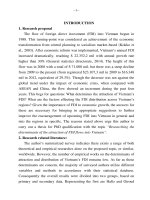
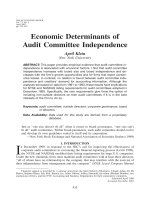
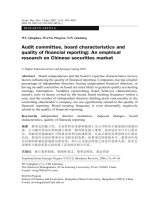
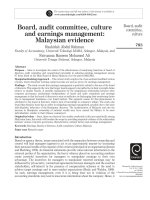
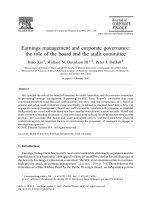
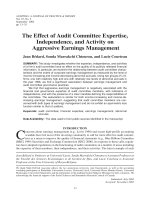
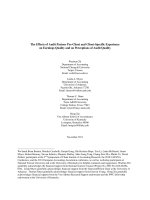
![anis - 2014 - auditors' perceptions of audit firm rotation impact on audit quality in egypt [mafr]](https://media.store123doc.com/images/document/2015_01/06/medium_ljh1420548080.jpg)
